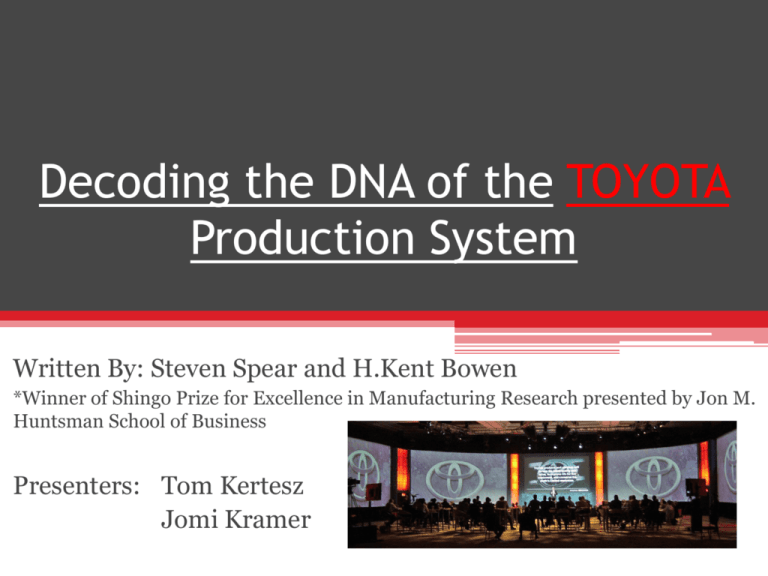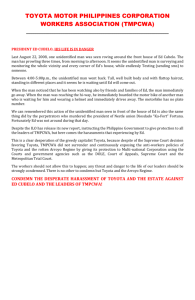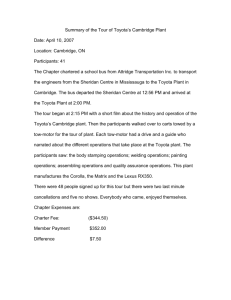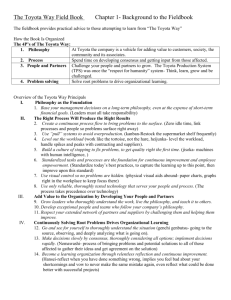Decoding the DNA of the TOYOTA Production
advertisement

Decoding the DNA of the TOYOTA Production System Written By: Steven Spear and H.Kent Bowen *Winner of Shingo Prize for Excellence in Manufacturing Research presented by Jon M. Huntsman School of Business Presenters: Tom Kertesz Jomi Kramer The Study of TOYOTA • Conducted over four years • Over 40 Plants • USA, Europe, Japan • Observation of routine production, discrete manufacturing, and service functions The system’s development • Hard to understand • Unwritten • Natural progression • 50 years of experience Community of Scientists • Quantifiable specifications • Problem solving • Experimentation Why is it difficult to decode the Toyota Production System? • The observers confuse tools and practices with the system itself • Paradox – rigidly scripted vs. flexible and adaptable • Constant change and improvement The Four Rules of TOYOTA 1. All work shall be highly specified as to content, sequence, timing, and outcome 2. Every customer-supplier connection must be direct and there must be an unambiguous yes-orno way to send requests and receive responses 3. The pathway for every product and service must be simple and direct 4. Any improvement must be made in accordance with the scientific method under the guidance of a teacher, at the lowest possible level in the organization The Four Rules of TOYOTA 1. All work is highly specified ▫ Content ▫ Sequence ▫ Timing ▫ Outcome The Four Rules of TOYOTA 2. All connections are direct ▫ ▫ Customer – Supplier Worker – Manager ▫ Standardized and direct ▫ No grey areas- Kanban “When something is everyone’s problem, it becomes no one’s problem” The Four Rules of TOYOTA 3. Simple and direct pathways ▫ Specified path ▫ Minimal change ▫ Each job has it’s ‘master’ ▫ Easy to test the hypotheses and spot the flaws The Four Rules of TOYOTA 4. Improvements made in accordance with the scientific method ▫ Teacher guidance ▫ Question everything! ▫ Examine both success and failure How Toyota’s workers learn the rules: • Unorthodox method • Guiding questions: ▫ ▫ ▫ ▫ How do you do this work? How do you know you are doing it correctly? How do you know that the outcome is free of defects? What do you do if you have a problem? • Methodical thinking • Critical for the system’s success Toyota's Notion of the Ideal • Incorporating a scientific way of thinking at all levels ▫ Ensures people will clearly state the expectation they will be testing when implanting change. • Common understanding of a ideal production system • Shared vision motivates one to make astounding improvements. Toyota's Notion of the Ideal • Toyota's workers view the ideal as concrete and consistent throughout the company: ▫ (Should be) Defect Free ▫ Delivered one request at a time ▫ Supplied on demand in the version requested ▫ Delivered immediately ▫ Produced in a safe work environment The Organizational Impact of the Rules The rules create an organization with a nested modular structure: • The workers become capable of and responsible for doing and improving their own work • The connections between individual customers and suppliers become standardized • The resolution of problems is pushed to the lowest possible level • People can implement design changes in their part without unduly affecting other parts. Summary • Unique – scientific way of thinking • Hard to understand and/or implement • This article seeks to help other companies apply the Toyota Production System using 4 basic guidelines Questions or Comments?






